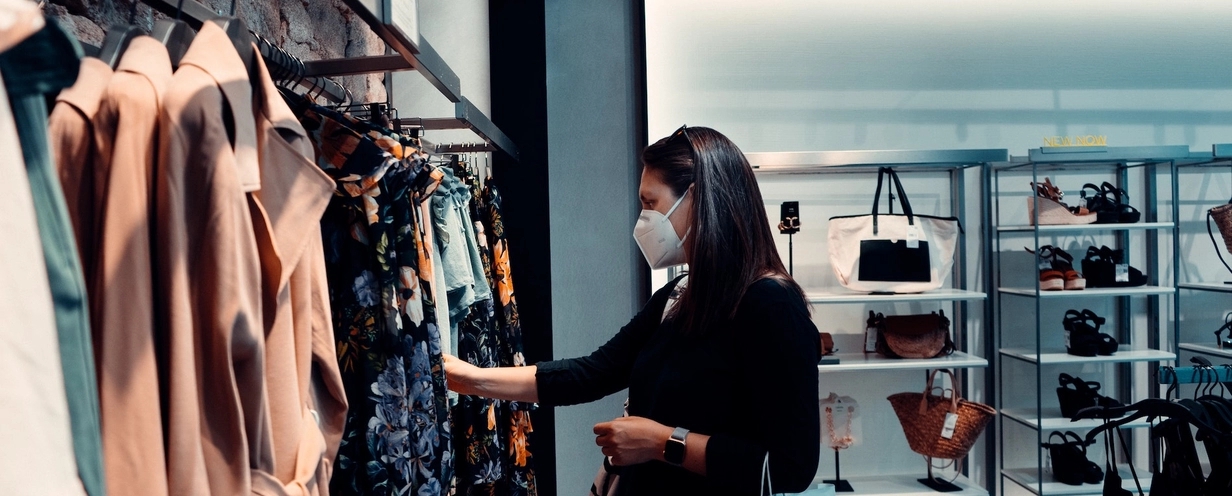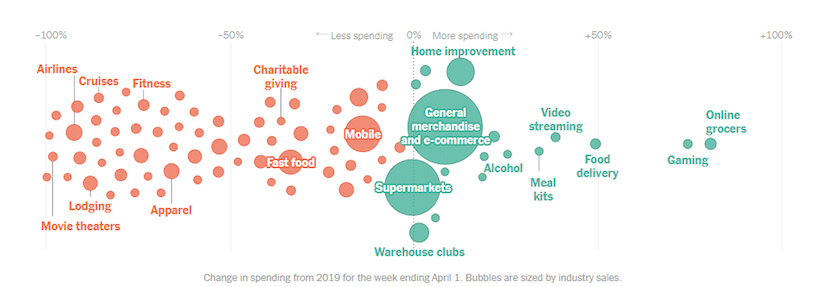
COVID-19 and changes in behavior: why you must relearn your customers

Although the world is always in a state of change, you'd be forgiven if you felt like that's more true recently. We might even be naive to think that things will stabilize or get back to normal anytime soon. Fortunately for us, humans adapt and grow to form new habits and behaviors that define who we are as a species. Which means “normal” may not ever be the normal we were once familiar with. People are traveling less, working from home more, minimizing in-person interactions, and moving many interactions to digital (if they weren’t already).
While you may have anecdotal evidence of these trends, the data that proves these massive shifts is even more powerful.

The chart above is a comparison of Q1 2020 consumer spending as compared to Q1 2019. As you can see, some industries like travel, entertainment, and restaurant/fast food have seen massive decreases in spending as people are sheltering in place.
You also see the industries that have experienced massive spikes in spending, including supermarkets, streaming media services, and home improvement as people spend more time at home. On the same token, you’ll notice a huge spike in ecommerce spending as most consumers change their shopping strategies by moving to digital channels and being very thoughtful about in-store visits.
So what’s most interesting about these numbers? Behind all the data are humans that are fundamentally changing the way they do things and make decisions. While the data tells us what’s happened, it doesn’t help you anticipate the change in behavior before it impacts your business.
The future of CX is tough to predict
If you were asked to predict how customer experience is likely to change in 2020, the odds wouldn’t have been in your favor. As it relates to retail, take a look at how this one consumer has altered the way she shops in response to the pandemic.
It’s interesting how she’s formed new shopping behaviors. For example, she saves up a list until she has enough to buy that makes the trip worthwhile, and she gets in and out of the store as fast as possible. You can empathize with her as she explains all of this.
And this is just one person. Imagine these shifts at scale—which is what we’re seeing in the data. However, this much shifting and changing is nearly impossible to make sense of by looking at numbers alone.
In fact, many AI models, which are built on previous behaviors (but designed to respond to changes), are breaking due to these unpredictable, massive shifts in behavior. For example, people searching for and buying disinfectant wipes, masks, and hand sanitizer in bulk don’t jive with existing consumer spending models and behaviors. And these shifts are showing cracks in machine-learning models which now are requiring human intervention.
As these models take previous behavior and fold in these radical new behaviors, the future becomes incredibly hard to predict. Therein lies the challenge with predictive models. They’re great at predicting the past, but not so great—especially in this current environment—at predicting the future.
So, we’re now in this interesting place in which all the customer behaviors you’ve grown to know and understand (even predict) may be null and void. You’re likely seeing shifts in behaviors, spending, and engagement, but you have to really understand the people behind this data to make sense of it and make forward-thinking decisions.
Build customer empathy to make forward-thinking, customer-centric decisions
Humans aren’t often driven by logic. We like to think we’re rational, logical beings, but in fact, we’re driven and motivated by our basic needs and fears. And we use a set of heuristics to make sense of the world. In heightened states of distress—which we’re all in at the moment—our behaviors and decisions are different. This is why we need to spend more time understanding our customers in this environment, what they need, the problems we can help them solve, and essentially, how we can make their lives easier, better, and less stressful.
This is when moving fast, being agile, and understanding the human needs within your customer base will set you apart. You don’t have time to watch data trickle in and make sense of it. For the first time in a while, businesses ought to step away from technology and replace it with customer empathy. And lean into an ongoing, rapid process of collecting human insights gleaned from customers.
Many companies are already doing this today, and we’re seeing that trend among some of the biggest and best brands in the world who are UserTesting customers. In fact, from looking at trends across our customer base, we’ve noticed that companies are getting feedback from consumers on how they’re reacting to COVID-19, how people are perceiving new brand messaging, and understanding shifts in behaviors. For example, retailers are talking to customers about how they plan for and create strategies around purchasing. Travel companies are connecting with their customers to gauge what they need to feel safe and secure getting on an airplane or checking into a hotel. And financial institutions are reaching out to their customers to understand their digital banking needs.
Without investing in these insights, you’re essentially throwing a dart at a dartboard and hoping you hit the target. It’s always been difficult to predict consumer behavior without understanding them, and it’s nearly impossible to be successful without empathizing and understanding them in the current environment. Ultimately, you can’t wait to see what people do and then react accordingly. It’s critical that you understand their current mind shifts now in order to make smart pivots. Without doing this, you’re likely to find yourself playing catch up.





